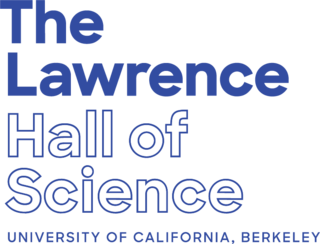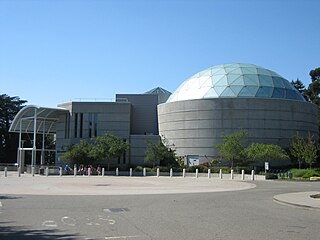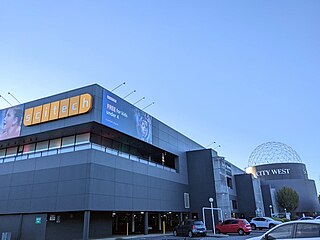
The Tech Interactive is a science and technology center that offers hands-on activities, labs, design challenges and other STEAM education resources. It is located in downtown San Jose, California, adjacent to the Plaza de César Chávez.

The Lawrence Hall of Science is a public science center in Berkeley, California that offers hands-on science exhibits, designs curriculum, aids professional development, and offers after school science resources to students of all ages. The Lawrence was established in 1968 in honor of physicist Ernest Orlando Lawrence (1901–1958), the University of California's first Nobel laureate. The center is located in the hills above the University of California, Berkeley campus, less than a mile uphill from the University's Botanical Garden.

Science North is an interactive science museum in Greater Sudbury, Ontario, Canada.

The Museum of Science (MoS) is a nature and science museum and indoor zoological establishment located in Science Park, a plot of land in Boston and Cambridge, Massachusetts, spanning the Charles River. Along with over 700 interactive exhibits, the museum features a number of live and interactive presentations throughout the building each day, along with scheduled film showings at the Charles Hayden Planetarium and the Mugar Omni Theater. Additionally, the Museum of Science is an accredited member of the Association of Zoos and Aquariums (AZA), being home to over 100 animals—many of which have been surrendered, confiscated, rescued or rehabilitated.

The Saint Louis Science Center, founded as a planetarium in 1963, is a collection of buildings including a science museum and planetarium in St. Louis, Missouri, on the southeastern corner of Forest Park. With over 750 exhibits in a complex of over 300,000 square feet (28,000 m2), it is among the largest of its type in the United States.

COSI, officially the Center of Science and Industry, is a science museum and research center in Columbus, Ohio. COSI was opened to the public on 29 March 1964 and remained there for 35 years. In 1999, COSI was moved to a 320,000-square-foot (30,000 m2) facility, designed by Japanese architect Arata Isozaki along a bend in the Scioto River in the Franklinton neighborhood. COSI features more than 300 interactive exhibits throughout themed exhibition areas.

Space Camp is an educational camp in Huntsville, Alabama, on the grounds of the U.S. Space & Rocket Center museum near NASA's Marshall Space Flight Center. It provides residential and educational programs for children and adults on topics such as space exploration, aviation, and robotics. Run by the Alabama Space Science Exhibit Commission, a state government agency, more than 900,000 campers have graduated since 1982, including several future astronauts.

The Houston Museum of Natural Science is a natural history museum located on the northern border of Hermann Park in Houston, Texas, United States. The museum was established in 1909 by the Houston Museum and Scientific Society, an organization whose goals were to provide a free institution for the people of Houston focusing on education and science. The museum complex consists of a central facility with four floors of natural science halls and exhibits, the Burke Baker Planetarium, the Cockrell Butterfly Center, and the Wortham Giant Screen Theatre. In 2022, the museum received 1,520,000 visitors, making it seventh on the List of most-visited museums in the United States, and was the third most-visited U.S. science museum. Much of the museum's popularity is attributed to its large number of special or guest exhibits.

The Boonshoft Museum of Discovery is a children's museum, science and technology center and zoo in Dayton, Ohio, United States that focuses on science and natural history. Exhibits include an extensive natural history collection as well as maintaining a collection of live animals native to Ohio and abroad. Educational outreach extends to the community by providing in-school programming and on-site special programs. SunWatch Indian Village and Fort Ancient are the sister sites to the museum.

The Milton J. Rubenstein Museum of Science and Technology is a science and technology museum located in the Armory Square neighborhood of Downtown Syracuse, New York. The Museum includes 35,000 square feet of permanent and traveling exhibits, Science Shop, and several programs and events. The MOST is located in the former Syracuse Armory.

Chabot Space and Science Center, located in Oakland, California, is a center for learning in Earth and space science, which features interactive exhibits, planetariums, a large screen theater, hands-on activities, and three powerful telescopes.

Scitech is a not-for-profit company encompassing the Scitech Discovery Centre, an interactive science museum in West Perth, Western Australia, outreach programs, professional learning programs and digital content.

The Michigan Science Center(MiSci) is a Smithsonian-affiliate science museum in Detroit, Michigan. The mission of the Michigan Science Center is to inspire curious minds of all ages to discover, explore and appreciate science, technology, engineering and math (STEM) in a creative, dynamic learning environment. As a 501(c)(3) nonprofit organization, MiSci relies on the generous support of donors, sponsors, community partners and members.

The McAuliffe-Shepard Discovery Center is a science museum located in Concord, New Hampshire, United States, next door to the NHTI campus. The museum is dedicated to Christa McAuliffe, the Concord High School social studies teacher selected by NASA out of over 11,000 applicants to be the first teacher in space, and Alan Shepard, the Derry, New Hampshire, native and Navy test pilot who became the first American in space and one of only twelve human beings to walk on the Moon. The Discovery Center's stated mission is to inspire new generations to explore space, through engaging, artful, and entertaining activities focused on astronomy, aviation, Earth and space science.

The Cox Science Center and Aquarium, formerly the South Florida Science Center and Aquarium, is a science museum located in West Palm Beach, Florida. Founded in 1959, the goal of the organization is to open every mind to science through the strategic programming of interactive exhibits and engaging community-based camps and events. The Cox Center has expanded since its creation and now houses over 50 hands-on exhibits, a planetarium, a 3000 square foot aquarium, a miniature golf course, and a large exhibit space that displays a temporary travelling exhibit. The Cox Center is a member of the Association of Science-Technology Centers program, which offers a membership that is redeemable at other ASTC science and technology centers around the world. The Cox Center occupies Dreher Park alongside the Palm Beach Zoo and offers deals for entrance into both facilities.

The Museum of Science & History (MOSH) is a museum in Jacksonville, Florida. It is a private, non-profit institution located on the Southbank Riverwalk, and the city's most visited museum. It specializes in science and local history exhibits. It features a large traveling exhibit that changes quarterly, three floors of permanent and signature exhibits, and the Bryan-Gooding Planetarium.

The Fairbanks Museum & Planetarium is a combination natural science museum, history museum, and planetarium located in St. Johnsbury, Vermont. It was founded in 1890 by businessman, politician, naturalist, and collector Franklin Fairbanks. The museum and its buildings are on the U.S. National Register of Historic Places.

The Planetarium Science Centre is a department in the Bibliotheca Alexandrina in Alexandria, Egypt. It promotes science centres as an educational tool.

The Mid-Hudson Children's Museum (MHCM) is a children's museum in the Hudson River Valley between the larger New York City and Albany markets. In 2022, as a result of a strategic assessment and visioning process, the museum extended the age range of the children it serves. With the addition of a new science exhibition and richer and more relevant STEM programming, it aims to elevate a child's ability and appreciation for learning through age 12. As a result, it has been re-branded from the Mid-Hudson Children's Museum to the Mid-Hudson Discovery Museum (MHDM).

The Eugene Science Center, located in Alton Baker Park in Eugene, Oregon, United States, is a science and technology center for children, families, and school groups. The 10,000-square-foot (930 m2) museum near Autzen Stadium features changing interactive exhibits, planetarium shows, camp programs, special events and other science and technology-related education programs. Eugene Science Center is an independent 501(c)(3) non-profit organization governed by a volunteer board of directors. Its mission is: "To engage children, excite their curiosity, inspire them toward a lifetime love of science, and empower them to use science and technology to improve their communities." Eugene Science Center is the only science museum in Lane County and surrounding counties.




















